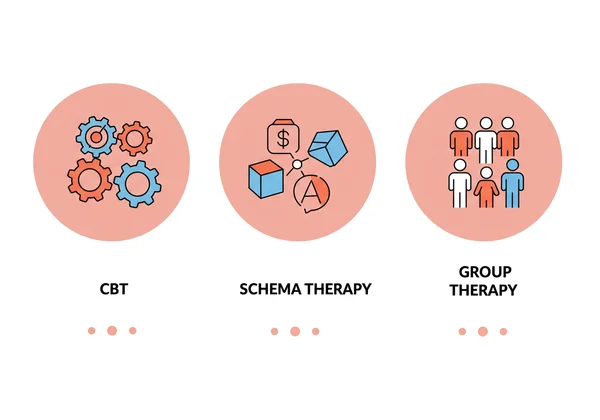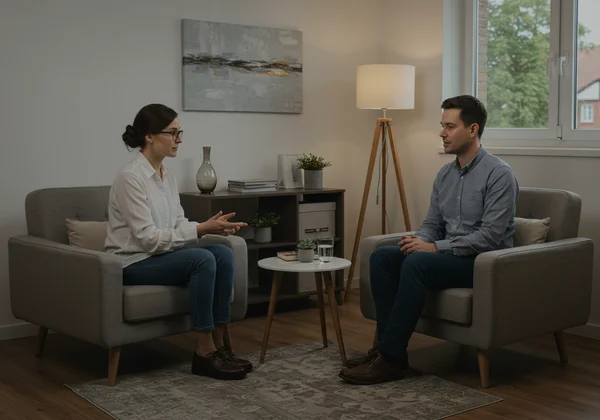AVPD Test Results: Next Steps for Professional Support
Taking a step to understand yourself better is a brave and significant act. If you've just completed an avpd test, you might be sitting with a mix of emotions: perhaps relief, confusion, or a bit of apprehension. You may be asking yourself, what do I do with this information now? This guide is here to walk you through what your results might mean and what supportive, empowering next steps you can take toward professional support and greater well-being.
The journey of self-discovery is personal, and having a starting point can make all the difference. An initial screening, like our confidential online AVPD test, is designed to be that first, gentle step. It provides a private space to explore your feelings without pressure or judgment. Now, let’s explore the path forward together.
Interpreting Your AVPD Test Results
Receiving your results is just the beginning. The score itself is not a label or a final verdict; it's a guidepost. It's a piece of information that can help you articulate feelings and patterns you may have been struggling with for a long time.
What Your AVPD Test Score Indicates
Think of your score as a flashlight in a dimly lit room. It doesn't reveal everything at once, but it helps illuminate a specific area. A higher score on an AVPD screening tool suggests that you may be experiencing a significant number of traits associated with Avoidant Personality Disorder. It indicates that the feelings of inadequacy, fear of rejection, and social inhibition you experience are consistent with those seen in AVPD.
A lower score might mean your symptoms are less frequent or intense, or they may align more closely with other experiences like social anxiety or shyness. Regardless of the number, the most important function of the score is to validate your struggles and give you a new language to understand them. The result from an am i avoidant test is simply a starting point for deeper reflection.

Beyond the Score: Understanding Potential AVPD Traits
Move beyond the number and reflect on the specific questions you answered. Which ones resonated the most? Was it the fear of criticism, the hesitation to join in social activities, or the feeling of being socially inept? Identifying these specific avoidant personality traits is far more valuable than the score alone.
These insights can help you pinpoint your personal challenges. For example, you might realize that while you are capable at work (sometimes referred to as high-functioning AVPD), your personal relationships are where you struggle most. Understanding these nuances is a critical part of the journey.
Why Seeking Professional Help for AVPD Matters
Self-awareness is powerful, but professional guidance can transform that awareness into meaningful change. While an online screening is an excellent first step, seeking help for AVPD from a qualified mental health professional is the most effective way to learn long-term coping strategies and improve your quality of life.
Overcoming the Fear of Reaching Out
For someone with avoidant traits, the idea of reaching out for help can feel terrifying. The very core of AVPD involves a deep-seated fear of judgment and rejection. The thought of being vulnerable with a stranger, even a therapist, can trigger immense anxiety.
Please know this fear is normal and understood. Therapists who specialize in this area are trained to create a safe, non-judgmental space. They expect you to be hesitant and will work at your pace. Your courage is not in being fearless, but in taking action despite the fear.

The Benefits of Professional AVPD Treatment
Engaging in professional avpd treatment offers benefits that self-help alone often cannot. A therapist can provide:
- Accurate Diagnosis: A professional can distinguish between AVPD, social anxiety, and other conditions to ensure you get the right support.
- Personalized Strategies: Therapy is not one-size-fits-all. A therapist will work with you to develop coping mechanisms tailored to your specific triggers and goals.
- A Safe Relationship: Therapy provides a unique opportunity to build a trusting relationship where you can explore your fears of intimacy and rejection without the risk of being hurt.
- Lasting Change: A professional can help you challenge and reframe the deep-seated negative beliefs about yourself that fuel avoidance.
Understanding Your AVPD Treatment & Therapy Options
When you're ready to explore professional help, it's useful to know what to expect. There are several effective avpd therapy options available, and a therapist will help determine the best fit for you.
Common Therapeutic Approaches for AVPD
Therapy for AVPD often focuses on building trust and gradually facing feared social situations. Some of the most effective therapeutic approaches include:
-
Cognitive-Behavioral Therapy (CBT): This therapy helps you identify and challenge the negative thought patterns (cognitions) and avoidance behaviors that define AVPD.
-
Schema Therapy: This approach goes deeper to explore the early life experiences that may have created the core beliefs of defectiveness or social isolation.
-
Group Therapy: While it may sound intimidating, a well-facilitated group can provide a safe environment to practice social skills and realize you are not alone in your struggles.

Is Medication a Part of AVPD Treatment?
While there is no specific medication treatment for AVPD itself, medication may be prescribed to help manage co-occurring conditions. Many people with AVPD also struggle with anxiety and depression. Antidepressants or anti-anxiety medications can help alleviate these symptoms, making it easier to engage in and benefit from therapy. This is always a decision made in consultation with a psychiatrist or medical doctor.
How to Talk to a Therapist About AVPD for the First Time
Knowing how to talk to a therapist about AVPD can reduce the anxiety of that first appointment. Remember, you are in control. This is your time to see if the therapist is a good fit for you.
Preparing for Your First Session: What to Bring Up
For your first session preparation, you don't need a perfectly rehearsed speech. You can simply be honest. Consider bringing:
- A brief summary of what brought you to therapy. You could even say, "I took an online AVPD quiz, and the results made me think I should talk to someone."
- A list of your main struggles (e.g., "I avoid parties," "I'm terrified of job interviews," "I feel lonely").
- Your goals for therapy (e.g., "I want to be able to make a new friend," "I want to feel less anxious around people").
Key Questions to Ask Your Potential Therapist
It's also a good idea to have some questions to ask your therapist to gauge their experience and approach. This empowers you in the process. You might ask:
-
What is your experience working with clients who have social avoidance or AVPD?
-
What does your therapeutic approach look like for these issues?
-
How do you work with clients who find it difficult to open up?
-
What can I expect in our first few sessions?

Taking the Next Step: Your Journey Towards Greater Well-being
You've already taken a courageous step by seeking information and completing an avpd test. Understanding your results and learning about the path to professional support is the next chapter in your journey. This is not about fixing something that is "broken," but about nurturing your well-being and building a life with more connection and less fear.
If you haven't yet, you can take the self-assessment on our homepage. If you have, we encourage you to use this information to continue your exploration. You are capable of change, and you deserve to feel secure and valued.
Disclaimer: This article is for informational purposes only. The online test is a screening tool, not a diagnostic instrument. Only a qualified mental health professional can provide a diagnosis and create a treatment plan. If you are in crisis, please contact a local emergency service.
Frequently Asked Questions About AVPD & Seeking Support
How do you know if you have avoidant personality disorder?
A definitive diagnosis can only be made by a licensed mental health professional, like a psychologist or psychiatrist, after a comprehensive evaluation. However, a scientifically-based screening tool, such as the free AVPD screening on our site, can be a valuable first step. It can help you identify if your patterns of thinking and behavior align with the core traits of AVPD, giving you a clear basis for a conversation with a professional.
How can I help myself if I have avoidant personality disorder?
Self-help can be a supportive part of your journey. Start by learning as much as you can about AVPD to understand its mechanisms. Practice small, manageable steps to challenge your avoidance—perhaps by making a low-stakes phone call or a quick trip to a store. However, these strategies are most effective when combined with professional therapy, which can provide structured guidance and support.
What does treatment for AVPD actually involve?
Treatment typically involves talk therapy designed to help you understand and change long-standing patterns. A therapist will help you identify the core beliefs that fuel your fears of rejection and inadequacy. Through methods like CBT, you'll learn practical skills to challenge negative thoughts and gradually expose yourself to social situations in a safe, controlled way, building your confidence over time.
Is avoidant personality disorder the same as being shy?
While they can look similar on the surface, they are different. Shyness is a common personality trait where a person feels awkward or timid in new situations or with unfamiliar people, but it usually doesn't prevent them from living a full life. AVPD is a pervasive, clinical condition where the fear of rejection is so intense that it causes significant distress and leads to widespread avoidance of social interaction, impacting work, relationships, and overall well-being. An online avpd test can help clarify these differences.